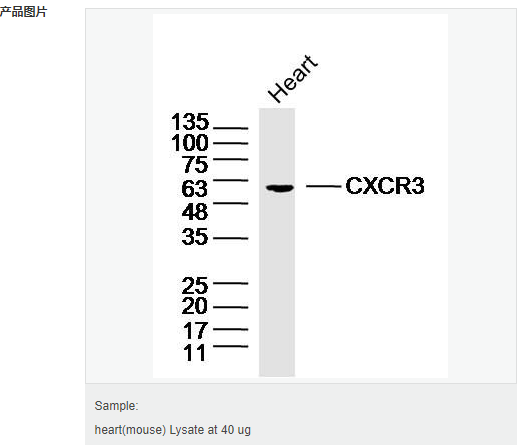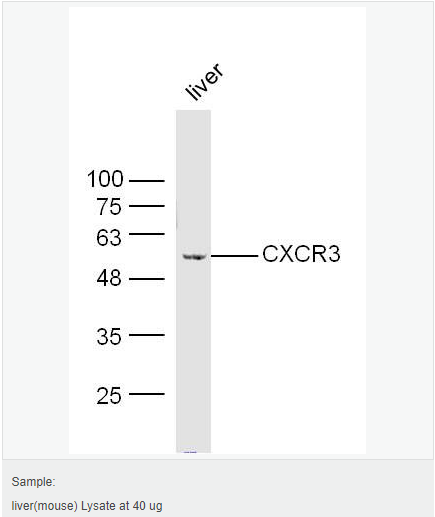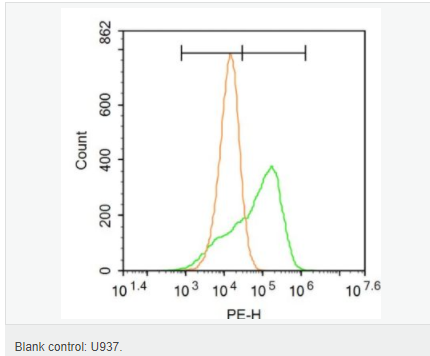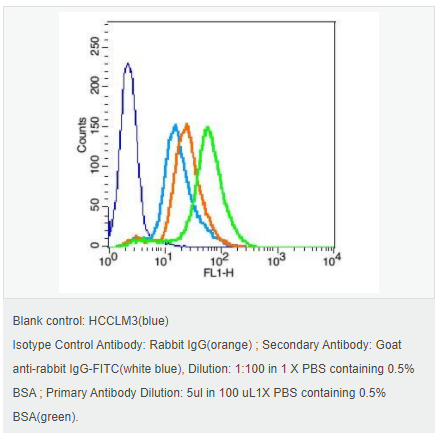

貨號(hào)
產(chǎn)品規(guī)格
售價(jià)
備注
BN41791R-50ul
50ul
¥1486.00
交叉反應(yīng):Human,Mouse,Rat(predicted:Dog,Pig,Cow,Rabbit,GuineaPig) 推薦應(yīng)用:WB
BN41791R-100ul
100ul
¥2360.00
交叉反應(yīng):Human,Mouse,Rat(predicted:Dog,Pig,Cow,Rabbit,GuineaPig) 推薦應(yīng)用:WB
BN41791R-200ul
200ul
¥3490.00
交叉反應(yīng):Human,Mouse,Rat(predicted:Dog,Pig,Cow,Rabbit,GuineaPig) 推薦應(yīng)用:WB
產(chǎn)品描述
| 英文名稱(chēng) | CXCR3 |
| 中文名稱(chēng) | 細(xì)胞表面趨化因子受體3抗體 |
| 別 名 | CXC-R3; Interferon-inducible protein 10 receptor; IP-10 receptor; CKR-L2; CD183 antigen; G protein-coupled receptor 9; C-X-C Chemokine receptor; CD183; CXC Motif Receptor 3; CKRL2; CMKAR3; G Protein Coupled Receptor 9; GPR9; IP10; IP10R; MIGR; CXCR3_HUMAN. |
| 研究領(lǐng)域 | 細(xì)胞生物 免疫學(xué) 信號(hào)轉(zhuǎn)導(dǎo) 細(xì)胞周期蛋白 細(xì)胞膜受體 G蛋白偶聯(lián)受體 細(xì)胞分化 |
| 抗體來(lái)源 | Rabbit |
| 克隆類(lèi)型 | Polyclonal |
| 交叉反應(yīng) | Human, (predicted: Mouse, Rat, Dog, Pig, Cow, Rabbit, Guinea Pig, ) |
| 產(chǎn)品應(yīng)用 | WB=1:500-2000 Flow-Cyt=0.2μg /test not yet tested in other applications. optimal dilutions/concentrations should be determined by the end user. |
| 分 子 量 | 40kDa |
| 細(xì)胞定位 | 細(xì)胞膜 |
| 性 狀 | Liquid |
| 濃 度 | 1mg/ml |
| 免 疫 原 | KLH conjugated synthetic peptide derived from mouse CXCR3:301-367/367 |
| 亞 型 | IgG |
| 純化方法 | affinity purified by Protein A |
| 儲(chǔ) 存 液 | 0.01M TBS(pH7.4) with 1% BSA, 0.03% Proclin300 and 50% Glycerol. |
| 保存條件 | Shipped at 4℃. Store at -20 °C for one year. Avoid repeated freeze/thaw cycles. |
| PubMed | PubMed |
| 產(chǎn)品介紹 | This gene encodes a G protein-coupled receptor with selectivity for three chemokines, termed CXCL9/Mig (monokine induced by interferon-g), CXCL10/IP10 (interferon-g-inducible 10 kDa protein) and CXCL11/I-TAC (interferon-inducible T cell a-chemoattractant). Binding of chemokines to this protein induces cellular responses that are involved in leukocyte traffic, most notably integrin activation, cytoskeletal changes and chemotactic migration. Alternatively spliced transcript variants encoding different isoforms have been found for this gene. One of the isoforms (CXCR3-B) shows high affinity binding to chemokine, CXCL4/PF4 (PMID:12782716). [provided by RefSeq, Jun 2011]. Function: Receptor for CXCL9, CXCL10 and CXCL11 and mediates the proliferation of human mesangial cells (HMC). Isoform 2 is a receptor for CXCL4 and also mediates the inhibitory activities of CXCL9, CXCL10 and CXCL11 on the growth of human microvascular endothelial cells (HMVEC). Interaction with CXCL4 or CXCL10 leads to activation of the p38MAPK pathway and contributes to inhibition of angiogenesis. Overexpression in renal cancer cells down-regulates expression of the anti-apoptotic protein HMOX1 and promotes apoptosis. Isoform 3 mediates the activity of CXCL11. Subcellular Location: Cell membrane; Multi-pass membrane protein. Tissue Specificity: Isoform 1 and isoform 2 are mainly expressed in heart, kidney, liver and skeletal muscle. Isoform 1 is also expressed in placenta. Post-translational modifications: Sulfation on Tyr-27 and Tyr-29 is essential for CXCL10 binding and subsequent signal transduction induction. N-glycosylated. Similarity: Belongs to the G-protein coupled receptor 1 family. SWISS: O88410 Gene ID: 12766 Database links: Entrez Gene: 12766 Mouse SwissProt: O88410 Mouse Unigene: 12876 Mouse Important Note: This product as supplied is intended for research use only, not for use in human, therapeutic or diagnostic applications. |



